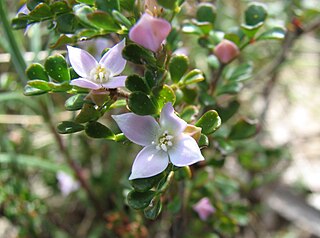
Boronia algida, commonly known as alpine boronia, is a flowering plant in the citrus family, Rutaceae and is endemic to south-eastern Australia. It is an erect shrub with many branches, pinnate leaves and white to bright pink, four-petalled flowers usually borne singly on the ends of branches.

Boronia safrolifera, commonly known as safrole boronia, is a species of flowering plant that is endemic to eastern Australia. It is an erect, woody shrub with pinnate leaves that have up to nineteen leaflets, and white to pink, four-petalled flowers.
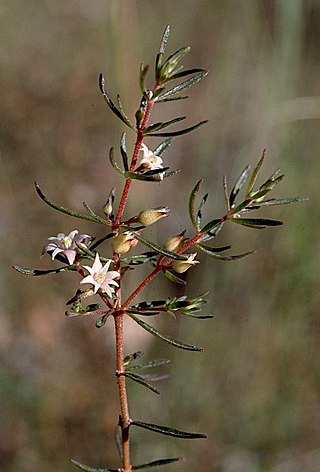
Boronia jucunda is a plant in the citrus family Rutaceae and is endemic to the far north-west of Australia. It is an erect shrub with many branches, pinnate leaves and white, four-petalled flowers. It is only known from a small area in the Kimberley region in Western Australia and in a national park in the Northern Territory.

Boronia lanceolata is a plant in the citrus family Rutaceae and is endemic to northern parts of the Northern Territory and Queensland. It is an erect shrub with many branches, elliptic to lance-shaped leaves and white or pink, four-petalled flowers. It is the most common boronia in the Northern Territory.
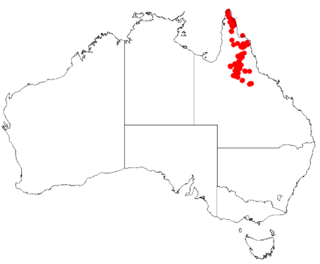
Boronia bowmanii is a plant in the citrus family, Rutaceae and is endemic to Queensland. It is an erect shrub with pinnate leaves and four-petalled flowers.
Boronia citrata, commonly known as lemon boronia, is a plant in the citrus family, Rutaceae and is endemic to Victoria. It is an erect, woody shrub with pinnate, strongly lemon-scented leaves and pale pink to rosy pink, four-petalled flowers arranged in groups of up to five.

Boronia decumbens is a plant in the citrus family Rutaceae and is endemic to northern parts of the Northern Territory. It is a low, spreading shrub with pinnate leaves and white to pink flowers with the four sepals larger than the four petals.

Boronia filicifolia is a plant in the citrus family, Rutaceae and is endemic to the far north-west of Australia. It is an erect or sprawling shrub with many branches, pinnate leaves with up to 55 leaflets and white to pink flowers with the sepals a similar length to the petals.
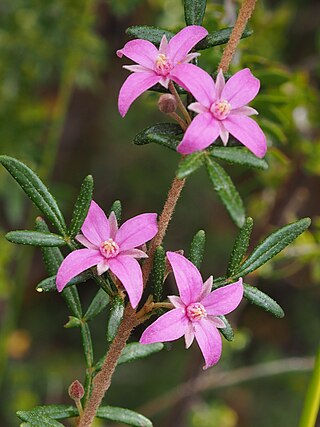
Cyanothamnus inflexus is a plant in the citrus family Rutaceae and is endemic to tablelands near the New South Wales - Queensland border in Australia. It is an erect, woody shrub with pinnate leaves and up to seven white to pink four-petalled flowers in the leaf axils. Boronia bipinnata is similar but has larger, bipinnate or tripinnate leaves and smaller sepals and petals.
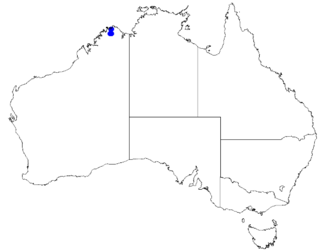
Boronia kalumburuensis is a plant in the citrus family Rutaceae and is endemic to the Kalumburu area of Western Australia. It is an erect or sprawling shrub with many branches, pinnate leaves and white to pink four-petalled flowers with the sepals longer and wider than the petals.
Boronia minutipinna is a plant in the citrus family Rutaceae and is endemic to a small area in the Kimberley region of Western Australia. It is an erect shrub with many branches, hairy stems and leaves, pinnate leaves and white to pink, four-petalled flowers with the sepals longer and wider than the petals.

Boronia quinkanensis is a species of plant in the citrus family Rutaceae and is endemic to a small part of Queensland, Australia. It is an erect shrub with most parts covered with star-like hairs and has pinnate leaves with up to eleven leaflets, and pink to white, four-petalled flowers.
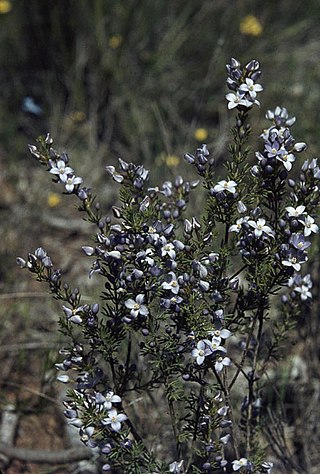
Cyanothamnus ramosus is a species of plant in the citrus family Rutaceae and is endemic to the southwest of Western Australia. It is an erect, mostly glabrous shrub with pinnate leaves with up to seven leaflets, and white, four-petalled flowers with blue or pale green backs.
Boronia rozefeldsii, commonly known as Schouten Island boronia, is a species of plant in the citrus family Rutaceae and is endemic to a small Tasmanian island. It is an erect, woody shrub with pinnate leaves and pink, four-petalled flowers. It is similar to B. pilosa which grows on the same island, but has larger petals and fewer hairs on the leaflets.

Boronia splendida is a species of plant in the citrus family, Rutaceae, and is endemic to Queensland, Australia. It is an erect shrub with most parts covered with star-like hairs and has simple, linear to narrow elliptic leaves, and pink to white, four-petalled flowers.

Boronia squamipetala is a species of plant in the citrus family, Rutaceae, and is endemic to Queensland, Australia. It is an erect shrub with pinnate leaves with between five and thirteen elliptic leaflets, and green to white, four-petalled flowers with hairy backs.
Boronia thedae, commonly known as the Theda boronia, is a plant in the citrus family, Rutaceae and is endemic to a small area in the Kimberley region of Western Australia. It is an erect shrub when young, later a prostrate shrub with many branches, pinnate leaves, four white to cream-coloured or pale pink sepals and four similarly coloured petals, the sepals longer and wider than the petals.

Boronia tolerans is a plant in the citrus family, Rutaceae and is endemic to a small area in the Northern Territory in Australia. It is an erect shrub with many branches, pinnate leaves and white, four-petalled flowers. It is only known from Nitmiluk National Park.

Boronia wilsonii is an erect shrub that is endemic to northern Australia. Its branches, leaves and backs of the flowers are densely covered with woolly hairs. The petals are white to pink or burgundy-coloured.
Cyanothamnus yarrowmerensis is a species of erect, woody shrub that is endemic to Queensland. It has pinnate or bipinnate leaves and groups of up to seven flowers with white petals in leaf axils.















